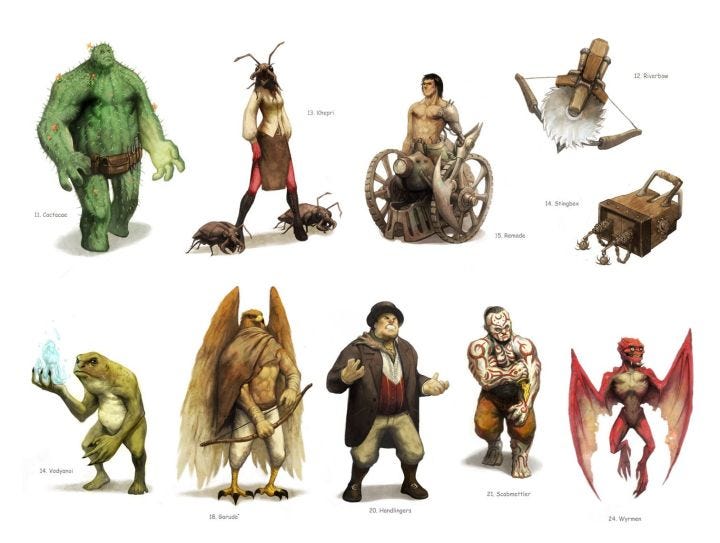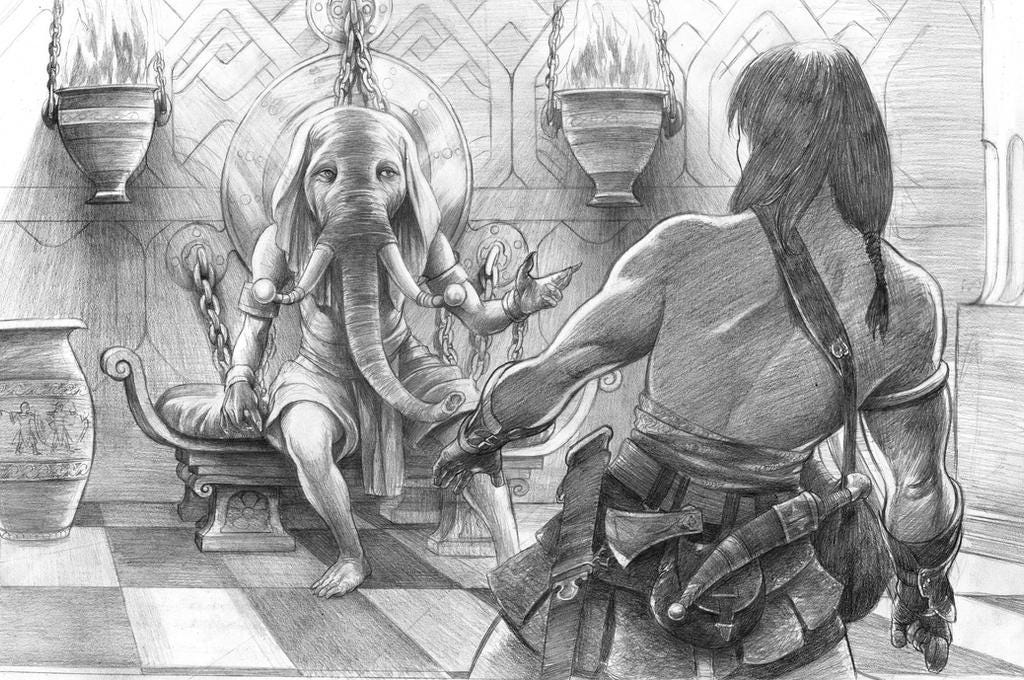This article, and - in fact - this whole Substack, is inspired by how many times1 I have argued about S3 Expedition to the Barrier Peaks. S3 is a module for Advanced Dungeons & Dragons 1st edition, published in 1980. It is well known for being the first official module to put science fiction elements firmly front and centre.
People argue that S3 is a gonzo work, and that it is the first gonzo work of its kind.
They are wrong.
Before we get into why, first we have to answer…
What is Gonzo?
The term comes from the gonzo journalism as coined by Hunter S. Thompson, which is a style charactised by a first-person perspective, high energy and deep social critiques. Also, often fuelled by drugs.
In tabletop RPG circles, gonzo refers to tabletop modules, settings and campaigns that mix settings and genres. If someone were to call a setting a “gonzo setting”, then they would be indicating that they cannot identify explicitly what sort of setting it actually is.
The earliest instance of "gonzo” in the tabletop space is a Grognardia review of S3. This likely means the term was being used on forums before this, with the term coming into use within the past two decades.
The above review actually references weird fiction, which - in my opinion - is a much better term for S3.
Gonzo is a derivative of weird fiction, the genre popularised by the pulp stories penned by the likes of Robert E. Howard, H.P. Lovecraft and Edgar Rice Burroughs.
Weird fiction itself was a type of speculative fiction with no clear boundaries on genre. Aliens in fantasy settings, magic in science fiction and everything in-between in the pastiches of the real world.
So where is the dividing line?
Weird Fiction as Classical vs Gonzo as Romantic
In my opinion, the division of these two genres can be considered from their focus, similar to that of “Classical” vs “Romantic” music2:
Classical: A focus on melody, with a desire for harmonisation of the disparate parts.
Romantic: A focus on feeling, on moving the audience regardless of harmony.
And so to apply it to what we are discussing:
Weird Fiction: A focus on presenting a snapshot of the world, with the implication that there is some deeper meaning behind this snapshot.
Gonzo: A focus on delivering emotions such as wonder, fear or joy, with no need for deeper meaning behind the emotions.
This means that in cases where there is a reason and meaning behind the genre-meld, it is weird fiction. In cases where that reason is not obvious or non-existent, it is gonzo.
Interestingly, the “new weird” as popularised by authors like M. John Harrison and China Miéville is a lot closer to gonzo than it is older weird fiction.
By now, you are probably wondering…
Why Gonzo?
Imagine for a moment that you have been running typical fantasy campaigns for ten years. You have played every monster, your players know all the tricks to defeat them and there is none of the joy of exploration that is core to tabletop roleplaying.
You could introduce weird elements and give them an explanation but that would be disruptive to the current campaign setting and quickly hit diminishing returns.
An eclipse of mothmen taking over the local villages would be fun for the first two encounters but the players would once again achieve mastery and lose the sense of discovery that you are trying to foster.3
So, you have the party ambushed by a group of mothmen. They have interesting abilities and the players must think on their feet to win.
They never see these mothmen again.
Now, however, you start bringing in things regardless of the basis of your setting. You consider the fun of the encounter more important than the slight fraying of belief that happens after every of encounters.
This is why people go for a gonzo setting and campaign style, and why I view gonzo as a “Romantic” style of fiction. The joy, the fear and the excitement are core to the style, rather than a reliance on or desire for a cohesive work.
Also, you can probably tell that gonzo is more of a reactionary genre rather than an explicitly developed one. It is a desire to move away from “stifling” genre limits to allow for a greater range of fiction.
Examinations of Examples
There are a nearly infinite number of potential examples to look at here but I am going to focus on three:
WEIRD - “The Tower of the Elephant” by Robert E. Howard (1933)
This story is about Conan infiltrating a tower to find a fabulous gem. While in there, he finds an alien (that looks vaguely like an elephant) that asks Conan to kill it so that he can get his revenge off his captor-apprentice in charge of the Tower.
This story is firmly weird fiction because the alien explains its origins and its reason for being in the tower. If it was there without that, it would likely fall into gonzo.
GONZO - “Broodmother SkyFortress” by Jeff Rients (2017)
This module is about a giant flying fortress with equally huge evil shark-centaurs that regularly come down to raid villages for people to eat.
It is gonzo. It offers potential reasons for the sharktaurs and their fortress to exist, but they are not core or needed for the premise. It exists because the writer thought it would be fun.
WEIRD - “S3 Expedition to the Barrier Peaks” by Gary Gygax (1980)
This module is about a flying saucer that crash landed into a mountain range (the eponymous Barrier Peaks) and, hundreds of years on, is leaking monsters into the surroundings.
S3 is weird fiction because everything in it makes sense within the context of the idea. You have a canteen that serves poisonous mush and robots trying to find a cure for the virus that killed the ships crew (which explains the whole concept of the crash). Some pieces strain credulity, like the stump-bunny, but overall there is a desire for cohesion.
As we can see, the dividing line is whether they seek to deliver an explanation of the different genre elements or whether they seek to deliver the emotional impact regardless.
Summary
Gonzo is not really my favourite genre, despite my deep and abiding love of weird fiction. I prefer the consistency and overall “realness” that more classical fiction tries to deliver.
Anyway, I hope that this was an informative post. My goal is to clarify some awkward regions of tabletop roleplaying, of which gonzo is merely the first.
If you agree or disagree, please feel free to drop a comment below. If you have any settings, stories or modules that you would like me to pass judgment on, then do so similarly.
Until next time, scholars!
Way too many. At least five times in the past month.
This is a simplification, please leave comments if you would like to argue about this.
It is also much more difficult to consistently do this than piecemeal elements.








Very interesting! I do love a bit of gonzo here, a bit of weird fiction there.
Wow, this is a little more intense than I anticipated. I never knew there were so many technicalities involved in this kind of thing. I think I could learn a lot. 🤔